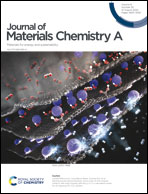Knitting aryl network polymers (KAPs)-embedded copper foam enables highly efficient thermal energy storage†
Abstract
Thermal energy storage (TES) is among the most powerful tools to alleviate the risk of fossil energy depletion. Latent heat density and thermal conductivity are the two most important parameters to evaluate the performance of TES materials. In this work, for the first time, we embed knitting aryl network polymers (KAPs) on the skeleton of copper foam (CF) in a biomimetic protocol, where the preparation process is inspired by the growing process of a natural coral and the obtained phase change material (PCM)-holding medium exhibits a bird nest-type morphology. Excellent energy storage performance was determined, where the thermal conductivity was up to 55.37 W m−1 K−1 and the encapsulation rate could reach 62.1% without the observation of any enthalpy attenuation even after a 300 energy charging and releasing cyclization, due to the relatively high surface area, i.e., 1079.1 m2 g−1 and high thermal conductivity of the copper skeleton inside. Further study revealed the good applicable properties in terms of shape adjustability, light-to-thermal and light-to-electric conversion.



 Please wait while we load your content...
Please wait while we load your content...